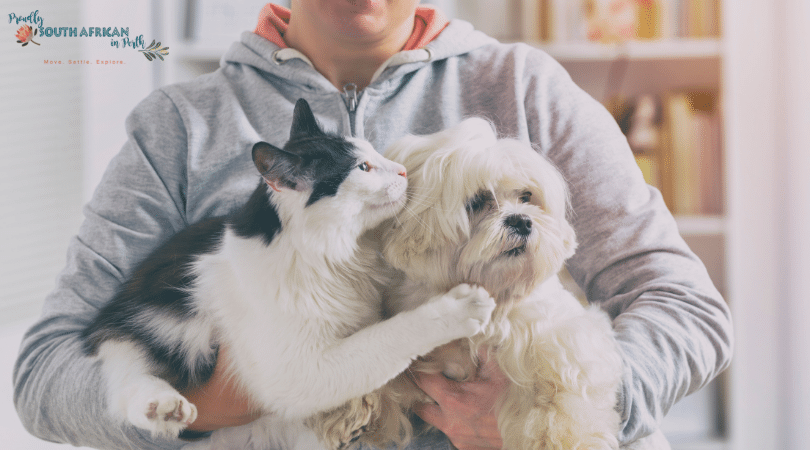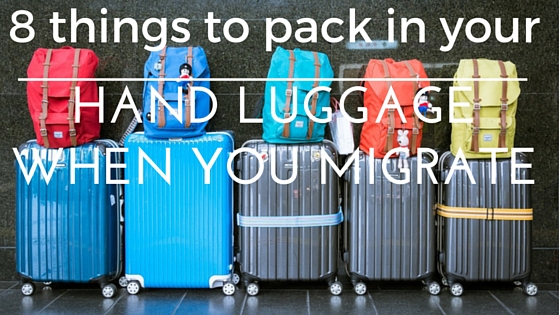When it comes to moving to Australia, for some people moving with their pets is a non-negotiable. But moving your pets to Australia can seem so daunting and tricky to work out.
So here’s some of the key information on what you need to know about moving your pets to Australia.
It would be impossible to cover every type of pet, as each species comes with its own conditions, each having their own complications. As it is mostly dogs and cats that are brought into Australia, we shall concentrate on these two pet species and keep this blog general.
Moving Dogs & Cats To Australia
The most common pets that people move to Australia and dogs and cats.
Dogs and cats may be brought into Australia under strict rules from approved countries, which have been categorized into 3 separate groups, with each group having their own set of conditions.
Groups 1 and 2 countries are recognized by the Australian Government as rabies-free, while Group 3 countries are not recognized as rabies-free. To check which group your country falls under, head to https://www.agriculture.gov.au/cats-dogs.
Animals You Can’t Bring To Australia
There are very limited species of animals that are actually allowed to enter Australia.
Only selected species of birds and rabbits from New Zealand are permitted to enter Australia.
Horses from certain approved countries are permitted. Unfortunately, South Africa is not an approved country for horses so bringing your horse directly from South Africa to Australia is not an option.
For all other species, you can use this tool to determine if your pet can be brought in and under what conditions. If no conditions are specified, then that species is not permitted.
Banned Dog Breeds
Some dog breeds are banned completely from entering Australia.
Dog breeds that are banned in Australia are:
- Pit Bull Terrier breeds, including American Pit Bull Terrier
- Dogo Argentino
- Fila Brasileiro
- Japanese Tosa
- Perro de Presa Canario or Presa Canario
The ban includes mix breeds of these breeds and to dogs that display any visible characteristics of the breeds mentioned above.
Breeds crossed with a non-domestic species, such as wolf are also banned from entering Australia.
The following hybrids are not permitted to enter Australia:
- Czechoslovakian wolfdog or Czechoslovakian Vlcak
- Lupo Italiano or Italian wolfdog
- Kunming wolfdog or Kunming dog
- Saarloos wolfdog or Saarloos wolfhound
Banned Cat Breeds
Domestic and non-domestic hybrids are not permitted in Australia.
Such hybrid cats include but not limited to the following:
- Savannah cat, domestic cat (Felis catus) crossed with serval cat (Felis serval)
- Bengal cat, domestic cat crossed with Asian leopard cat (Prionailurus bengalensis)
- Chausie, domestic cat crossed with Jungle cat (Felis chaus)
- Safari cat, domestic cat crossed with Geoffroy cat (Oncifelis geoffroyi)
Declaring Your Breed
When submitting an application to import to the Department of Agriculture, Water and the Environment, you must specify the breed of your dog or cat and sign a declaration stating that the breed is not an illegible breed.
For more information contact the Australian Department of the Environment and Energy.
Approved Vets & Laboratories
It is your responsibility to ensure that the vets and laboratories that perform all veterinary checks and procedures on your pet, are officially recognised by the country of export.
If the animal is from a non-approved country, the laboratory performing the initial rabies antibody testing, must either be the Australian Animal Health Laboratory or one of the OIE rabies reference laboratories listed in that non-approved country.
Rabies
All pets relocating to Australia, must undergo a rabies antibody titre test 3 to 4 weeks after receiving their rabies vaccination.
This blood test is to ensure that your pet has a sufficient level of anti-bodies and must be done by an accredited laboratory from their country of export.
Blood Tests
Cats and dogs are also required to undergo additional treatments and blood tests prior departure.
Your accredited laboratory or vet will ensure all necessary treatments are carried out within the set time frames preventing unnecessary setbacks and delays.
Vaccinations & Microchipping
The department strongly recommend that dogs imported to Australia be vaccinated against Distemper, Hepatitis, Parvovirus, Para-influenza and Bordatella. Dogs arriving from the USA or Singapore also need to be vaccinated against the canine influenza virus (CIV). Vaccines must be administered at least 14 days before departure.
Cats and dogs also need to be treated against internal parasites twice before entering Australia. Cats also need two treatments for external parasites. All procedures must be 14 days apart and the second treatment must be within 5 days from departure.
The department strongly recommends all cats and dogs are registered with a national microchip registry in Australia. Animals must be implanted with a microchip that can be read by Avid, Trovan, Destron or an ISO compatible microchip reader. Pets should be scanned at each visit to the vet and must be scanned before any pre-export blood tests are carried out.
If the microchip cannot be read in Australia or the number is not consistent with any import paperwork, the animal may be exported from Australia. Microchip scanners can be sent with the animal to ensure the chip can be scanned and verified upon arrival in Australia. Most microchip numbers are either 9, 10 or 15 digits long and any numbers starting with 999 are not acceptable.
Your government accredited vet or laboratory will be able to offer any further advice.
Import Permits
Importing a dog or cat from New Zealand or Norfolk Island does not require an import permit, although certain medical conditions apply.
Animals for all other countries require an import permit. This can be applied for online and there are fees applicable.
See the current import fees for cats and dogs to Australia.
As of 2021 the fees are as follows:
Lodgement – first cat or dog in consignment – $120
Assessment – first cat or dog in consignment – $360
Total – first cat or dog in consignment – $480
For each additional pet in the same consignment the fees are:
Lodgement – subsequent cats & dogs – $120
Assessment – subsequent cats & dogs – $120
Total – each subsequent cat & dog in consignment – $240
Pet Travel To Australia
Cats and dogs cannot travel with you on the plane but must travel as manifest cargo, which allows for traceability and must arrive directly into Melbourne International Airport. They cannot land at any other Australian airport.
Due to Australian border closures and limited incoming flights, there is currently a temporary arrangement between Qantas and the department in place, where animals can be flown to Melbourne from Sydney, but only if no direct flights to Melbourne are available.
Eligible assistance dogs may be exempt from travelling as manifest cargo and some airlines allow them to travel in the cabin. For more about bringing your assistance dog to Australia, head here.
On Arrival In Australia
On arrival in Melbourne, your pet will be transferred to the post entry quarantine (PEQ) facility for at least 10 days. They may have to stay for longer if any issues that may increase biosecurity risk arise.
They will remain in quarantine until a successful blood test clears them for release. Following that you will be able to collect your pet or they will be able to travel to their final destination in Australia.
Invoices For Animal Quarantine Fees
You will receive two invoices for the cost of your animal’s stay in the post entry quarantine (PEQ) facility in Melbourne.
The first invoice is a set fee that includes:
- standard veterinary inspection of the animal and health certification
- document assessment
- an International Documentation Fee (IDF) charged by the local airport freight handler
- the daily rate for quarantine accommodation.
These fees are the set minimum charges that can be calculated for your animal ’s quarantine isolation period. You have to pay this invoice in full before your booking will be confirmed.
The second invoice is a variable fee that includes any additional fees due to circumstances such as:
- subsequent inspection/s caused by non-compliant or incomplete documentation arriving with the animal
- subsequent daily fees where import conditions have not been met
- transportation costs caused by delayed flights
- service fees if your animal requires hospitalisation in the case of an emergency
- any other third party expenses incurred during the quarantine isolation period.
Should You Use A Pet Travel Company?
As you have probably gathered already, importing any pet to Australia can be an extremely complicated affair with so much that can go wrong.
Although not mandatory, it is highly advisable to use a pet travel company and take out all the unnecessary stress for you and your pets. Pet travel companies also stay up to date with any regulatory changes leaving nothing to chance. Any unanticipated government delay or setback could easily extend the quarantine period of your pet, placing it under more stress and hardship, and also increasing the costs substantially.
There are so many species of animals, birds, fish reptiles, etc that are cannot be brought into Australia. There are also many laws that apply to different countries, so it makes perfect sense to let an experienced pet travel company to take care of your pet’s move to Australia.
For more information or to find an trusted pet travel company, visit the International Pet and Animal Transportation Association (IPATA) website.
How Long Will It Take To Move Your Pets To Australia?
How long it takes to move your pet to Australia will depend on your country of origin.
If you’re coming from a Group 3 country which is not considered rabies-free, it is recommended that you begin the process at least 7 months prior to the move.
For Group 2 countries, which do not require rabies preparations, starting the process 3 months ahead of the move should be sufficient.
It is further recommended that you discuss the process with an Australian government-approved vet in your home country.
How Much Will It Cost To Bring Your Pets To Australia?
Over and above the transport costs, which will vary according to your country of origin and the different airlines, the minimum costs for one dog or cat that undergoes the mandatory 10 days’ quarantine, will be around $2000.
These will cover import permit application fees and quarantine station fees. Costs could easily escalate if the quarantine period is extended if the pet is suspected of harboring any disease or parasite and more testing be required.
Fees are also subject to change and it is your responsibility to verify these costs and procedures before booking. A partial payment for the animal’s quarantine accommodation has to be paid at the time of booking.
See a full breakdown of animal quarantine costs in Australia.
Someone who recently moved her pets to Australia shared her total breakdown of costs with me and that came to R33,000 ($3,300 AUD) per cat and just under R40,000 ($4,000 AUD) for her dog.
I hope you’ve found this post about moving your pets to Australia useful. If you have more questions about moving pets to Australia, leave them in the comments below and I’ll do my best to help or point you in the right direction for relevant information.






No Comments